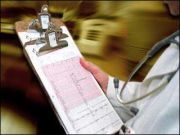Article
Comparison of the Utility of a Validated Questionnaire with Daily Electronic Diary Entry in Patients with Chronic Angina
Author(s):
Study results confirm the validity of the Seattle Angina Questionnaire section focusing on chronic angina frequency, showing it correlated strongly with patients' daily diary entries regarding angina frequency and medication use.

Suzanne V. Arnold, MD, a cardiologist with Saint Luke’s Mid America Heart Institute in Kansas City, MO, and colleagues reported results from a study that examined the relationship between angina frequency and utility at the 2013 American Heart Association Scientific Sessions in Dallas, TX.
Nearly 8 million people in the US suffer from chronic stable angina and there is limited data evaluating the effectiveness of angina treatments. Health utility values are needed to conduct cost-effectiveness analytics; however, Arnold said these are missing from the majority of anti-angina clinical trials.
The Seattle Angina Questionnaire (SAQ), a widely-used coronary artery disease (CAD)-specific health status tool, has not been validated against daily records of angina frequency and sublingual nitroglycerin (SL NTG) use. Evidence supporting the validity of the SAQ could justify its broader use as an outcome measure for clinical studies designed to evaluate treatments that improve patients’ angina symptoms.
The current study looked at data from patients with type 2 diabetes, CAD, and stable angina from the multinational Type 2 Diabetes Evaluation of Ranolazine in Subjects with Chronic Stable Angina (TERISA) trial. The number of angina episodes and SL NTG used were recorded and transmitted daily with an electronic diary. Researchers compared the SAQ (4-week recall) cross-sectionally with the preceding 4 weeks of patients’ diaries, focusing on the two corresponding SAQ Angina Frequency (AF) questions (ie, frequency of angina and SL NTG use). Longitudinal changes in SAQ AF scores from baseline to 8 weeks were compared with changes in diary responses over the corresponding time period. Analyses were also stratified by age, sex and geography.
Of 949 randomized subjects, 917 had complete diary and SAQ data. Participant’s mean age was 64 years, with men making up 61% of the study group.
The researchers concluded that chronic angina patient health utility values decrease as angina frequency increases. Patients reporting at least a minimally important improvement in angina frequency experience a tangible improvement in health utility. In a multinational cohort of patients with stable angina, the SAQ AF domain was strongly correlated cross-sectionally and moderately correlated longitudinally with daily diary entry of angina frequency and AL NTG use. This data further support the validity of the SAG AF domain across a broad spectrum of patients with stable angina.




